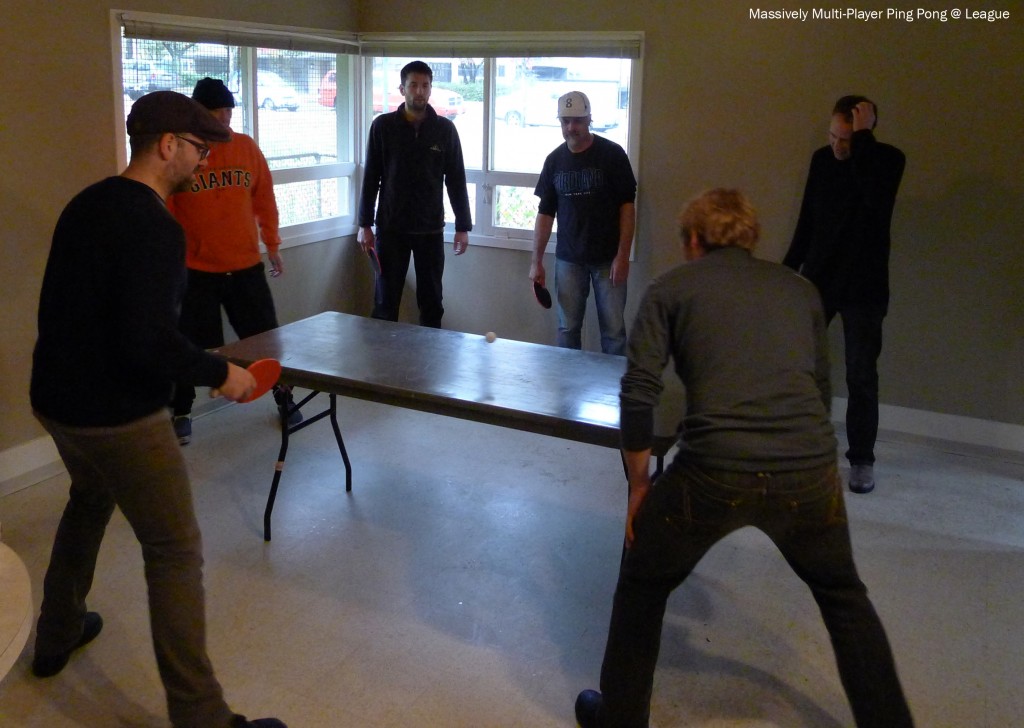Notes from kickoff day, a rainy Sunday, October 14.
After realizing that the borrowed couch wouldn’t fit through the field house door, we strung up a tarp outdoors and tried three different activities: Couchie, Monkeying Around Training Program, and Massively Multi-Player Ping Pong.
 1. Couchie
1. Couchie
Cedric Bomford, Mike Love and Verena Kaminiarz introduced us to Couchie, a game invented in Cedric and Mike’s apartment in college years.
Basic description:
 Players take turns hurling beanbag juggling balls into an overstuffed couch, attempting to lodge them in the cracks. Different cracks are worth different points, depending on the difficulty, with the small vertical crack between the front cushions worth the most. Points are lost for missing the couch completely or stepping over the line. First team to break 750 points wins.
Players take turns hurling beanbag juggling balls into an overstuffed couch, attempting to lodge them in the cracks. Different cracks are worth different points, depending on the difficulty, with the small vertical crack between the front cushions worth the most. Points are lost for missing the couch completely or stepping over the line. First team to break 750 points wins.
Modifications made:
- When played in teams, one player from each team take turns pitching their team’s three balls, then you move on to the next matchup. Trade balls with each matchup.
 A small number of points were given for hitting the back wall and landing in the crack between frame and back cushions.
A small number of points were given for hitting the back wall and landing in the crack between frame and back cushions.- Large penalty added for completely missing couch and landing the ball in the washroom.
- Clarified that you cannot touch in front of the line, even if the ball is released before you land.
- Extra points for stacking all three of one’s balls in a single vertical crack (aka Orion’s Belt).
Observations:
- Consensus amongst first-time players: much more fun than expected.
- There seem to be skills that can be perfected. Mike, the historic champion, was by far the highest scorer.
- Both a light touch and power seem to be viable techniques.
2. Monkeying Around Training Program
Rob Larson brought an idea about an open-source exercise activity that could be done anywhere in public: Monkeying Around. The idea, somewhat related to parkour, is that we should feel free to move playfully and in ways that don’t have to follow routines, and that the repertoire might grow as users add movements. It borrowed from capoeira some movements, the surrounding circle, and some rhythmic elements and sounds. Rob had us bounce like monkeys and crab- and bear-walk on all fours, first moving on our own, then facing off by pairs in the middle of a circle.
Feedback:
- There were some inhibitions to get over, partly because of unfamiliar movements, partly from feeling self-conscious about being in the centre of the circle.
- Could be interesting to have people move in ways related to different animals, kind of like different styles of martial arts.
- One way to get people out of their shells could be to have a goal of some sort.
- To be workshopped some more.
3. Massively Multi-Player Ping Pong
Nat Bailey introduced us to a game he’s used as a game-design exercise: Massively Multi-Player Ping Pong (MMPPP).
Basic description:
This is a game for as many people as you have paddles. Players are numbered, and play in order. The table is a ping-pong table without the net, or any other kind of table. Each shot must hit the table three or more times then once on the floor (rolling on the table counts as infinite bounces). If the next person doesn’t make their shot, the last person to make a successful shot gets a point.
Modifications/precisions:
- No penalty for not making a shot; serve just passes the the next person.
- Walls and other surfaces are in play.
Observations:
- The number of people changes the game quite a bit. With more people, inattention and crowding become issues.
- Playing order makes a difference.
- Good positioning seems to be to set up across the table from the person playing, but guile can be a factor.



Germaine Koh on November 13, 2012 at 5:38 pm said:
Forwarded from Ian at Roadhouse Interactive: “The scoreboard from ‘Couchie’ at Roadhouse. Note some of the new combos in addition to ‘Orion’s Belt’ – ‘The Cat Butt,’ ‘The Shoulders’ and ‘The Slit’.”
http://www.facebook.com/photo.php?fbid=371718799589122&set=o.193481627452491&type=1&theater